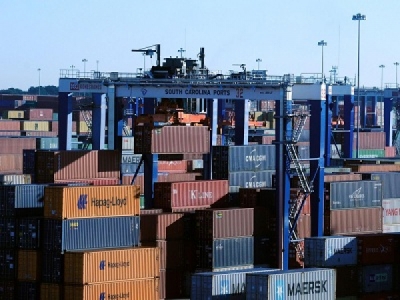
Posted on May 15, 2018
By Ron Brinson, The Post and Courier
There is no question that deepening federal navigation channels in Charleston Harbor to 52 feet is a sound public investment that will generate broad state and national benefits.
But there is a question as to how reliable the federal government is as a partner in this $570 million investment for which it is responsible for covering about $270 million.
Consider that the Panama Canal’s deeper and wider locks are open; bigger ships are here — and dominating global supply chain logistics. Charleston’s deepening project is underway on a strategically critical timetable. Funding for the state’s share is in place and in use. The federal share, though, lags in a vortex of confusion, promises and congressional inaction.
The overarching risk is a costly suspension of the dredging projects that will make Charleston the deepest container ship port on the East Coast — and a setback to the State Ports Authority’s “bigger ships” strategies now spurring notable market share growth.
And that’s a risk the ports authority clearly understands. The agency has quietly asked the state Legislature for a loan to sustain the project on its current timetable. The collateral is the federal “promise” to fund its share. Reportedly, the ports authority wanted a $100 million bridge loan. Budget drafts indicate $50 million is more likely to be approved.
The state, it seems, has little choice. Its commitment was etched in 2012 in a wave of competitive awareness. Two decades ago, the Port of Charleston’s grand development plans for Daniel Island were derailed even as the Port of Savannah’s expansion marched ahead. In just a few years, market shares for the two ports inverted; Savannah dominated the South Atlantic markets and more and more South Carolina cargoes were transiting the Savannah River.
Jim Newsome, then in his third year as the ports authority’s chief executive, led a determinative meeting of the minds among legislators and the Charleston maritime community — deepening the harbor would give Charleston and the state the ultimate advantage to attract the bigger ships market.
State Sen. Hugh Leatherman, R-Florence, saw it all as “good policy for our state’s future, plain and simple.”
“It was important that we make a clear and firm statement: We are committed to making Charleston the most modern port on the East Coast, not just to compete with Savannah or other ports, but to serve the business and industry of our state that need the best port we can provide.”
Leatherman, as chairman of the Senate Finance Committee, engineered a $300 million escrow account to cover the state’s share. It was a bold move, Leatherman’s “clear and firm” statement that South Carolina was serious about harbor deepening.
Applying expedited “Smart Planning” validation procedures, the Corps of Engineers moved Charleston’s project quickly through its paces. Elected federal officials gushed over how well the reformed bureaucratic process was working, and soon congressional authorizations were in place. The ports authority dutifully committed to its role and, with faith that Congress would take care of its funding responsibilities, work began.
So did the cash flow issues.
President Trump’s fiscal 2019 budget proposed nothing for the federal share. That’s critical because the deepening of channels leading to Charleston’s workhorse Wando Welch terminal is advancing.
Newsome and his board reluctantly turned to the Legislature, even as they redoubled efforts to get South Carolina’s congressional delegation to prompt the Trump administration and Congress to become as committed to funding as they had been to authorizing this project.
The federal government lagging in harbor dredging commitments is nothing new. The Office of Management and Budget constantly juggles commitments, and federal dredging projects too often get squeezed. Some suspect that South Carolina’s willingness to provide up-front financing is a convenient reason to lower its spending priority. The Port of Oakland, California, fronted the full costs of its 50-foot deepening project that became operational in 2009. Nearly a decade later, the feds finally coughed up their share.
The port industry, though, had high hopes that with the Corps’ “Smart Planning” processes, timely funding disciplines would soon follow. Clearly that did not happen and expectations that it will anytime soon should be carefully measured.
In fact, chances are the ports authority will be returning to the Legislature for help. “We need $90 million from them every year for three years to keep the project on schedule,” Newsome told The Post and Courier’s David Wren last month. “We’re not deepening the harbor just for fun. The big ships are here now.”
Using its balance sheet capital for the federal share, Newsome also noted, would require the ports authority to delay its commitments to other development projects, such as the $750 million Leatherman Container Terminal.
Sen. Leatherman sees two issues.
“We simply can’t let this project stall out,” he said. “We are committed to the port, period.”
And as to the risk of advancing the federal share: “I intend to talk to Senator [Lindsey] Graham and others about that.”
Let that conversation begin soon, senator, and perhaps it might start with a gentle reminder that the Port of Charleston is a cash cow for the federal government. Customs collections, for example, are estimated at nearly $1 billion annually. That should get their attention.
Source: The Post and Courier





